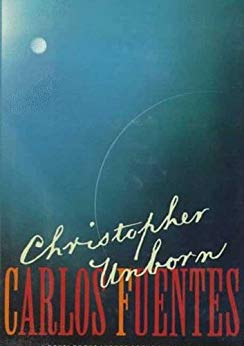
The cover of the U.S. edition of Christopher Unborn
As I’d mentioned in my previous post, I am in the middle of revisiting and expanding on a chapter whose two central texts are Cabeza de Vaca’s Naufragios and Cooper’s The Last of the Mohicans. As part of that work, this morning I thought I would re-read the opening chapter of Carlos Fuentes’ 1987 novel Cristóbal Nonato (Christopher Unborn), since that section in particular is one of the other texts I take up in that chapter. In so doing, I realized that earlier remarks about another novel I’ll be discussing in that same chapter, along with commentary by Fuentes himself, will serve to reinforce some of my project’s larger claims about the Baroque and the New World, this time with a focus on literary aesthetics. All of that, I hope, will tie in (I hope not hog-tying style) with the politics of Martí and Mariátegui that I’ll also be adding to this chapter.
(The perils of “quick re-reads”: This post’s original title, when I started on it two days ago, had in it the phrase “a few quick comments.” So you see . . . )
The other novel is by Cuban novelist Guillermo Cabrera Infante: Tres tristes tigres (1967; translated as Three Trapped Tigers). Its title (the first line of a Cuban tonge-twister) and its description by its English translators, David Gardner and Susan Jill Levine (with assistance from the author) of having been translated “from the Cuban” alert the reader that it is no ordinary novel.
